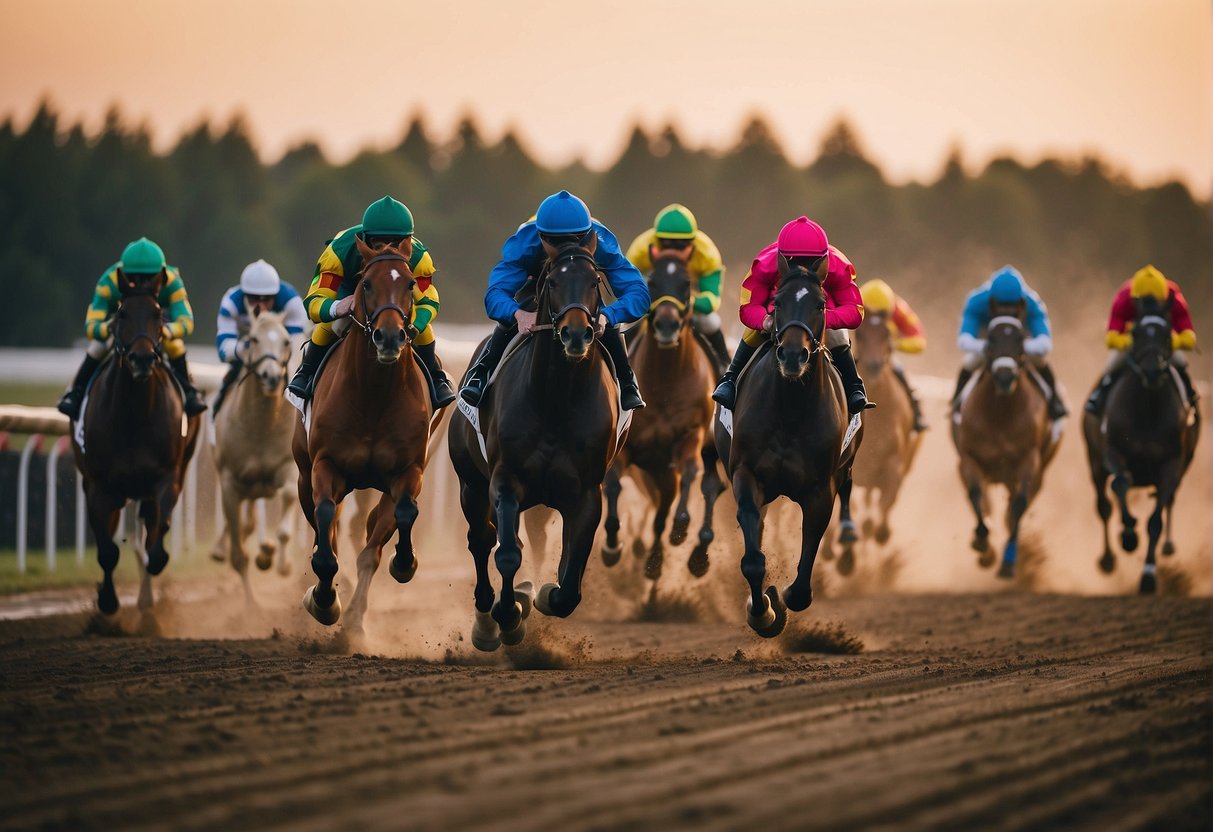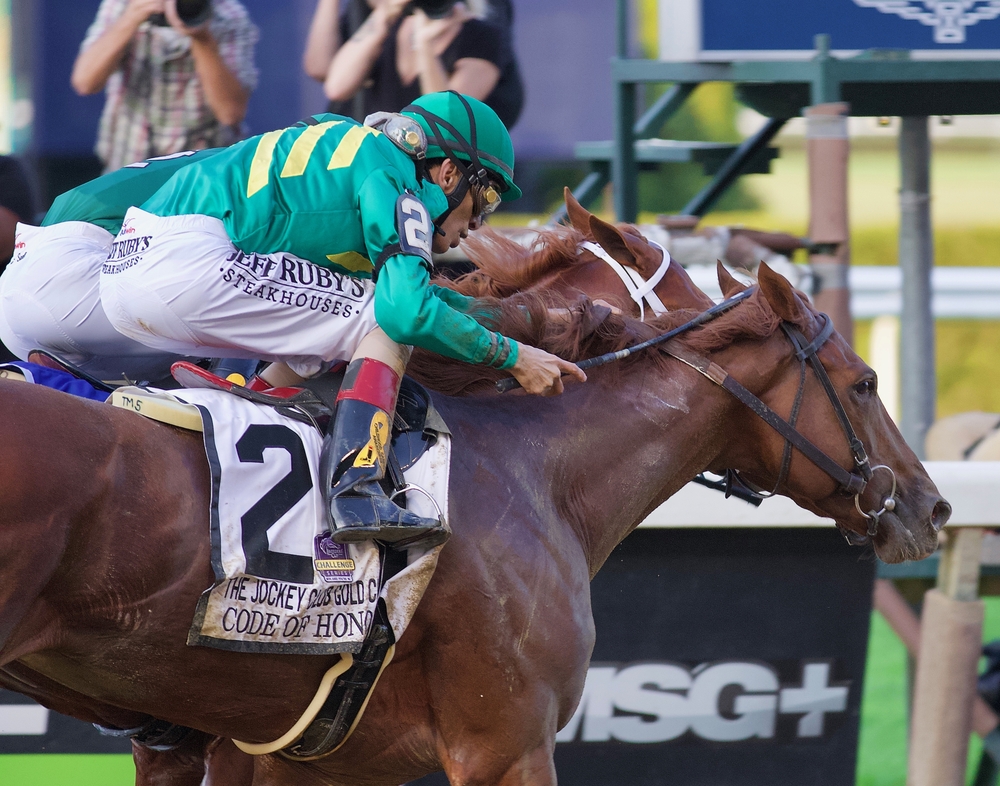In-running betting on horse racing has revolutionised the experience for punters by offering a dynamic way to bet while a race unfolds. Unlike traditional betting, which requires bets to be placed before the start of a race, in-running betting allows bets to be placed as the race is occurring, providing an opportunity to capitalise on the live action and fluctuating odds. This form of betting has surged in popularity with the advent of online betting exchanges.

Capitalising on in-running betting requires an understanding of not just the sport and its participants, but also a good grasp of the various strategies that can be employed. Punters need to have their fingers on the pulse of not only the race’s progress but also market movements, making decisions on the fly to secure potential profits. The technical aspects of in-running betting, such as the use of advanced tools and real-time data analysis, play a crucial role in making informed bets.
Key Takeaways
- In-running betting allows for placing bets during a horse race.
- Strategic knowledge and timely decision-making are imperative for profit.
- Technical tools and market analysis significantly influence betting success.
Understanding In-Running Betting
In-running betting, also known as in-play or live betting, allows bettors to place bets on horse racing events as they are taking place. This alternative to traditional pre-event betting presents unique opportunities for value and requires an understanding of its mechanics.
The Basics of In-Play Betting
In-running betting is the process of making wagers on horse races as the event occurs, offering dynamic odds that change with the on-track action. Bettors can assess the form and performance of horses in real-time, which can be advantageous in finding value that pre-race odds may not have reflected. The key to successful in-play betting lies in the bettor’s ability to interpret live developments quickly and place bets accordingly.
Advantages of Betting in Running
The primary advantage of in-running betting is that it gives bettors the ability to gauge the race’s flow and identify horses that are performing unexpectedly well or poorly. This can provide bettors with an edge in finding better odds, especially if they can spot something that others may have missed. In-running betting also adds an exciting layer to watching races, as bettors feel more engaged with the live action.
- Increased flexibility: Bettors can make decisions based on what they’re seeing, allowing for adjustment of strategies mid-race.
- Potential for better odds: In some instances, in-play odds may exceed pre-race odds, especially for horses that start poorly but are known strong finishers.
Need Help Beating the Bookies?
Our expert betting tipsters have been taking cash off the bookies since 2014! If you need a helping hand with winning then why not check them out?
Browse Our Tipsters
Systematic Betting
Simple and Effective Horse Racing Tips from a Hugely Popular Member of the Team
Visit PROFILECommon In-Running Betting Markets
Several in-running betting markets have become prevalent.
- Win Market: Bettors can back a horse to win the race, with odds fluctuating as the event unfolds.
- Place Market: Similar to the Win Market, but bettors wager on horses to finish in one of the predetermined top positions.
- Match Bets: These are wagers between two horses in which a bettor predicts which one will finish higher, regardless of their actual positions.
These markets require bettors to be attentive to live race conditions, as odds can shift quickly and drastically, creating opportunities for high-value returns for the well-informed bettor.
Key Concepts in Horse Racing

Understanding the intricacies of race dynamics, jockey decision-making, and interpreting equine performance is crucial in horse racing. These fundamentals provide punters with insight into the many factors that influence the outcome of a race.
Race Dynamics and Running Styles
Race dynamics are shaped by the running styles of the horses within a race. Front runners are horses that excel when leading from the start, often setting a blistering pace. Hold up horses, in contrast, are known for their ability to conserve energy and surge at the critical moment, typically making a strong finish. Envisioning how the race will unfold is key; knowing if the pace will be fast and likely to favour front runners, or slower, giving the hold up horses a better chance, is part of assessing the dynamics.
Jockeys and Decision-Making
Jockeys play a pivotal role in the outcome of a horse race through their decision-making and ability to adapt to the race’s unfolding narrative. Their choices in positioning and when to urge their horse forward are crucial. A jockey’s talent is not just in guiding a horse, but also in interpreting the race as it progresses and making split-second decisions that could mean the difference between winning and falling short.
Interpreting Horse Performance
Interpreting a horse’s performance in past races provides vital clues to their potential in an in-running betting scenario. Factors such as speed ratings and past performances in similar race conditions are indicators of a horse’s ability to repeat a strong showing. This analysis involves looking beyond raw finish positions to understand the context of each performance.
Effective Betting Strategies
In the dynamic world of in-running horse race betting, successful punters use strategies like back-to-lay and lay-to-back tactics, alongside a keen eye for value in in-running odds, to gain an advantage.
Back to Lay Strategy
The Back to Lay strategy involves initially backing a horse at higher odds, with the intention of laying it off at a shorter price as the race unfolds, thus securing a profit regardless of the race outcome. Punters use this strategy when they anticipate that a horse will start off strong or when the horse’s odds are expected to shorten during the race. They must quickly assess the horse’s performance and decide the optimal moment to lay their bet.
Lay to Back Strategy
Conversely, the Lay to Back strategy requires punters to lay a bet at shorter odds before the race begins, and then back the same horse at longer odds in-play. This strategy is favourable when a horse typically has a weaker start or is known to finish strong. The punters hope the prices will drift out, allowing them to back the horse at higher odds, which can result in considerable profits if the horse’s performance improves as predicted.
Value Seeking in In-Running Odds
Seeking value in in-running odds is crucial for profitable betting strategies. Punters look for instances where the odds available are greater than the actual chance of an event occurring. This involves an in-depth understanding of the market and its fluctuations, the use of tools for real-time analysis, and often, an individual insight into specific horses’ performance patterns. Betting exchanges commonly provide better value than traditional bookmakers owing to the real-time nature of the odds adjustments during the race.
Choosing the Right Betting Exchange
When selecting a betting exchange for in-running horse racing, it is crucial to consider factors such as liquidity, the range of exchange features, and how they measure up against industry leaders like Betfair Exchange.
Understanding Liquidity
Liquidity refers to the amount of money available for betting on a given market. High liquidity ensures that bettors can place large bets at the desired odds without significantly affecting the market price. Betfair Exchange often leads in liquidity, which is a vital aspect for any bettor to examine. Here’s how one might assess liquidity:
- Check active markets: More active markets generally correlate with better liquidity.
- Look at the available money: Large sums in the matched and unmatched sections indicate good liquidity.
Higher liquidity typically leads to tighter odds and more efficient price discovery.
Comparing Exchange Features
Each betting exchange offers a unique set of features that can affect the betting experience. To compare exchanges, bettors should evaluate the following:
- Commission Rates: Lower rates can increase net profits.
- In-Running Interfaces: Smooth and responsive platforms are crucial.
- Terms and Conditions: These should be fair and transparent.
- Support Services: Reliable customer support is essential for resolving issues quickly.
A comprehensive comparison table of selected exchanges with these features can aid in making an informed decision.
Betfair Exchange as a Benchmark
The Betfair Exchange is the standard against which other betting exchanges are often measured. It boasts a high degree of liquidity, comprehensive in-running betting options, and innovative features. When considering alternatives, remember these attributes that set Betfair apart:
- Market Availability: Availability of various markets, especially for in-running betting.
- Technology: Advanced technology for a seamless betting experience.
- Reputation: An established reputation for reliability and fairness.
By using Betfair Exchange as a benchmark, bettors can gauge the quality of other exchanges effectively.
Technical Aspects of In-Running Betting
In-running betting on horse racing demands precision, as the outcome can be influenced significantly by timing and information accuracy. The technical components are critical in ensuring bettors can make informed decisions in real-time.
Impact of Time Delays
Time delays can critically affect the success of in-running betting. A delay, even of a few seconds, between the live event and the broadcast can result in missed opportunities and flawed decision-making. In essence:
- Live Feed Delays: Bettors should be aware that televised or streamed races may suffer from a slight broadcast delay compared to the actual live event.
- Betting Platform Delays: When placing bets, a gap between real-time events and bet execution may occur, impacting the odds considerably.
Importance of Fast and Accurate Information
The value of fast and accurate information cannot be overstated in in-running betting. It allows bettors to:
- Make decisions based on the most current state of play.
- Access timely data, which is crucial in a sport where conditions can change in a matter of seconds.
Utilising Real-Time Data
Real-time data empowers bettors with immediate insights into the race as it unfolds, which is essential for:
- Identifying and capitalising on betting opportunities that may only exist for a brief period.
- Live Streaming: Platforms that offer real-time or near real-time streaming provide a significant advantage for in-running betting, allowing bettors to observe and react to live events as they happen.
Utilising these technical aspects efficiently can greatly enhance the betting experience and potentially improve the outcomes of a bettor’s in-running wagers.
Market Analysis and Research
Analysing the horse racing betting market requires a meticulous approach to studying form and historical data, monitoring real-time market movements, and identifying common betting patterns. These practices are crucial for making informed decisions in the dynamic environment of in-running betting.
Studying Form and Historical Data
The study of form involves a detailed examination of each horse’s past performances, considering factors such as the racecourse, distance, and the conditions on the day. Historical data is vital; it provides insights into how horses have performed under similar circumstances to those they will face in an upcoming race. A bettor’s ability to research and interpret this data directly impacts their betting decisions.
Important factors to consider:
- Racecourse: Some horses perform better on certain tracks.
- Distance: The length of the race can affect a horse’s performance.
- Conditions: Weather and track conditions are crucial variables.
Monitoring Market Movements
Monitoring the betting market involves observing the odds fluctuations as they respond to various factors like betting volume, insider information, and external conditions. Movements in odds can indicate where informed money is going, which can be a strong guide to a horse’s chances. It is essential for betting enthusiasts to track these changes actively for the most accurate positioning before and during the race.
Key Elements to Monitor:
- Odds Fluctuations: Significant changes in odds can signal market confidence.
- Volume of Bets: High betting volume can affect the odds and indicates popular interest.
Identifying Betting Patterns
Recognising betting patterns is about understanding how the public bets and recognising anomalies that can suggest insider knowledge or a collective assessment of a horse’s chances. Experienced bettors often look for these patterns in order to find value bets where the odds may be more favourable than the actual chances of a specific outcome.
Patterns to Look For:
- Persistent backing of a specific horse
- Sudden spike in bets on an underdog
- Shifts in odds shortly before the race starts
Psychology of Betting In Running
The fast-paced nature of in-running betting on horse racing challenges bettors to stay composed and to understand the flux within the betting markets. Decisions must be made swiftly, and understanding the collective mindset of traders and competition is crucial.
Managing Emotions and Discipline
Bettors who succeed in the frenetic environment of in-running betting on horse races exhibit exceptional emotional control and discipline. As prices fluctuate rapidly during the race, traders must resist impulsive decisions driven by the highs and lows of the competition. A structured approach, often underpinned by pre-defined rules such as stop losses or maximum stakes, helps maintain a steady course amidst the volatility.
To illustrate:
- Stop loss: Set a limit to the amount one is willing to lose on a bet to prevent emotional decision-making in the heat of the moment.
- Maximum stakes: Determine the maximum stake for each bet to manage financial exposure and ensure decisions are not influenced by potential returns alone.
Understanding Market Psychology
The psychology of the betting market is complex, as it encompasses the collective behaviour of all participants – bettors and traders alike. Market prices reflect the prevailing sentiment about the likely outcomes as the race unfolds. Traders who anticipate shifts in market psychology can position their wagers to capitalise on price movements before they become widely recognised by the competition.
Key considerations include:
- Market sentiment: Being attuned to how the sentiment is changing in response to race dynamics.
- Odds movement: Identifying the patterns in odds movement to predict future fluctuations.
Understanding market psychology involves recognising that every participant’s action is guided by their interpretation of the race’s progression, and as such, the market is a reflection of the collective emotion and strategy of its traders and bettors.
Glossary of Terms
When participating in horse racing betting, particularly in-play or Betting In Running (BIR), it is essential to understand specific terms related to betting strategies. Below is a categorised list of key terms used in the industry.
Betting Types:
- Backing: Placing a bet on a horse to win.
- Laying: Offering a bet on a horse to lose.
Outcomes:
- Winners: Horses that finish first in their race.
- Losers: Horses that do not finish in a winning position.
- Favourites: Horses considered most likely to win, often having the lowest odds.
Wagering Strategies:
- Accumulator Bet: A bet involving multiple selections; all must win for the bettor to secure a return.
- Tricast/Trifecta: Predicting the first, second, and third place finishers in exact order.
These terms form the foundation of a bettor’s vocabulary and are crucial in navigating the dynamic and fast-paced world of in-play horse racing betting. Being well-versed in this jargon can make the experience both enjoyable and potentially profitable.
Frequently Asked Questions
This section provides concise answers to common queries on in-play horse racing betting, outlining strategic approaches and considerations for effectively engaging with live events.
What strategies should a punter consider for in-play horse racing betting?
Punters should consider the horse’s performance under pressure and its habitual reactions during a race. Knowledge of a horse’s past form can inform decisions on when to place a bet during the race, as certain horses perform better under specific conditions.
How do back and lay betting options work on betting exchanges like Betfair?
On betting exchanges, a back bet entails betting on a horse to win, whereas a lay bet involves betting against a horse to win. Punters can adjust their positions as the race unfolds, offering flexible betting strategies that reflect real-time race developments.
What are the key factors to evaluate when placing bets on live horse racing events?
Evaluating key factors includes considering the horse’s current form, the jockey’s performance, track conditions, and the horse’s behaviour during the race. Live odds and market movement on betting exchanges can also provide insights into how to place strategic bets.
How does one effectively interpret horse racing form and Timeform ratings for in-running betting?
Punters should analyse historical performance data, including Timeform ratings, to understand a horse’s potential. Form indicators show how a horse has performed in similar conditions, and ratings can signal competitive advantages or disadvantages in a race.
What are the common pitfalls to avoid in in-running horse racing betting?
Avoiding common pitfalls involves not placing bets based on impulse or incomplete information. Punters should refrain from chasing losses with poorly considered wagers and should always be aware of the delay in broadcasting, which can affect the timing of bets.
How should distance and track conditions influence in-running betting decisions?
The distance of the race and track conditions significantly impact a horse’s performance. Punters should consider how a horse has historically performed at different distances and under various track conditions, adjusting their betting strategies accordingly.






